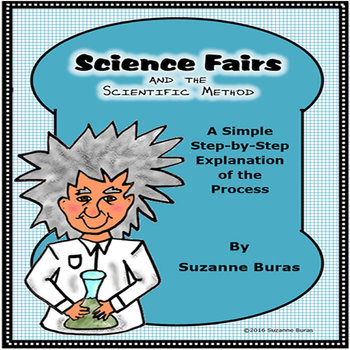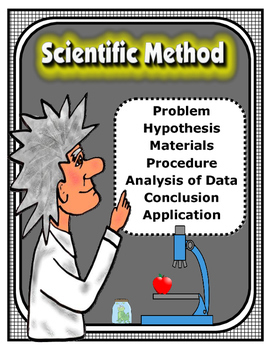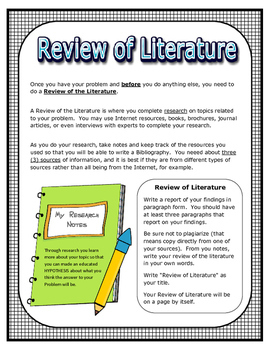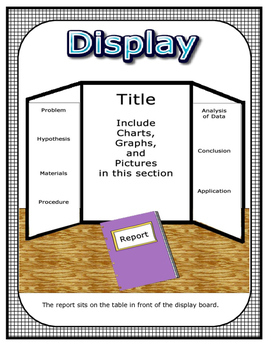Science Fair Projects: A Step-by-Step Guide
- Zip
Also included in
- This bundle includes 12 different packets that focus on the Scientific Method. All of the packets can be purchased separately or as this bundle which is discounted by 20%. Packets included:Science Fair Projects: A Step-by-Step GuideIt's Science, but Is It Scientific Method?Length, Mass, Volume, anPrice $30.82Original Price $34.25Save $3.43
- Help is on the way! This product includes both of my Science Fair Step-by-Step Guide products. They each include the same information. One is in a handout format to be distributed to students and parents, and the other is a PowerPoint presentation that can be made to a class, a school-wide parentPrice $11.03Original Price $12.25Save $1.22
Description
This packet was created for my fifth grade class and for other 4th, 5th, and 6th grade classes for the school's Science Fair. It provides detailed, step-by-step, illustrated directions for completing a Science Fair Project based on the Scientific Method.
The guidelines can be used for any level of experimentation whether it be a simple mini project in class or a full-blown Science Fair Project that will be competing in a school, regional, or state science fair.
Both a PDF and WORD (editable if you have WORD) document are included.
Also available in a PowerPoint Presentation format! Great for whole class and Parents' Info Night presentations!:
Science Fair Projects: A Step-by-Step Guide- PowerPoint Version
Also included is a Timeline for completing the project and a Scoring Form that can be used by teachers in the classroom for a grade or for judges in a more formal school-wide fair.
The packet includes illustrated guidelines on the following:
Scientific Method Poster
The Problem
The Review of Literature
The Bibliography
The Hypothesis
The Materials
The Procedure
Doing the Experiment
The Graph
The Analysis of Data
The Conclusion
The Application
The Abstract
The Final Report
The Display Layout
Parts of the Display Board
Tips for Winning Display Board
The Oral Presentation
Science Fair Timeline
Judges Scoring Sheet
Science Fair Categories
Credits
Visit Suzanne's Classroom Store!
The resources are designed to enrich or supplement your current curriculum.
Other Related Products:
Science Fair Projects: A Step-by-Step Guide
What Is the Scientific Method?
It's Science, but Is It Scientific Method?
Mini Science Fair Project: Surface Tension Lab
Scientific Method Lab: Does Air Weigh Anything?
Race to Earth: Gravity and Air Resistance Lab
Scientific Method Lab: Paper Airplane Model Design
Length, Mass, Volume, and Density Labs
Creating a Catapult: Accuracy and Precision Lab
Scientific Method: Rate of Speed Lab
Scientific Method Lab Assessment Idea (Freebie!)
I hope this packet will be helpful to those of you who venture out to do "REAL" science using the Scientific Method!!! It is my hope that this will provide you, your students, AND YOUR STUDENTS' PARENTS with a friendly guide.
Be sure to rate the packet! You get TpT credits, and you help me in my attempt to produce quality products! Many thanks!
The National Science Education Standards states that "Scientific inquiry reflects how scientists come to understand the natural world, and it is at the heart of how students learn. From a very early age, children interact with their environment, ask questions, and seek ways to answer those questions. Understanding science content is significantly enhanced when ideas are anchored to inquiry experiences. Scientific inquiry is a powerful way of understanding science content. Students learn how to ask questions and use evidence to answer them. In the process of learning the strategies of scientific inquiry, students learn to conduct an investigation and collect evidence from a variety of sources, develop an explanation from the data, and communicate and defend their conclusions. The National Science Teachers Association (NSTA) recommends that all K–16 teachers embrace scientific inquiry and is committed to helping educators make it the centerpiece of the science classroom. The use of scientific inquiry will help ensure that students develop a deep understanding of science and scientific inquiry." (NSTA Position Statement: Science Inquiry. 2004, http://www.nsta.org/about/positions/inquiry.aspx.)







